The ARM vs x86 Wars Have Begun: In-Depth Power Analysis of Atom, Krait & Cortex A15
by Anand Lal Shimpi on January 4, 2013 7:32 AM EST- Posted in
- Tablets
- Intel
- Samsung
- Arm
- Cortex A15
- Smartphones
- Mobile
- SoCs
Krait: Idle Power
We'll start out our power investigation looking at behavior at idle. Although battery life when you're actually using your device is very important, having a fast SoC that can quickly complete tasks and race to sleep means that you need to be able to drive down to very low idle power levels to actually benefit from that performance. Here we're looking at power consumption at the Start Screen in Windows RT/8. You'll notice that there are two distinct periods during the benchmark, with the latter part of the graph showing lower power consumption thanks to the live tiles going to sleep. In this test, WiFi is enabled but there's no background syncing of anything. WiFi being on is why we continue to see power spikes even after the live tiles have gone to sleep:
The W510 does a great job of drawing little power at idle. Its silly WiFi implementation results in peak idle power consumption that's very similar to the Dell XPS 10, but the lowest the platform hits is appreciably lower than anything else. Surface RT remains the more power hungry of the three, while the XPS 10 falls somewhere in between MS and Acer.
If we isolate CPU core power alone though, things are a bit different. Keep in mind that we don't have the L2 power island instrumented, so the XPS 10 looks a little better than it should here but minimum CPU power consumption is very good on Krait. Although the Atom Z2760 is built on a special SoC derivative of Intel's 32nm process, I do suspect that it's not quite as low power as TSMC's 28nm LP. Things may change by the time 22nm rolls around however. All meaningful compute transistors here should be power gated, and what we end up looking at is the best case leakage for all SoCs. The Krait/28nm LP combination is awesome. I'm not sure why Tegra 3 is so much more active here towards the very end of the curve by comparison.
Adreno 225, or at least whatever Qualcomm drives off of the GPU power rail is extremely power efficient at idle. The PowerVR SGX 545 curve looks flatter at the end but Qualcomm is able to hit lower minimum power levels. It's not clear to me how much of this is architecture vs. process technology. On the GPU side there is some activity happening here as the display is still being refreshed even though the system is idle, so we're not looking at purely power gated consumption here.
To take the WiFi controller out of the equation, I tossed all tablets into Airplane mode and re-ran the same tests as above. You'll notice much less fluctuation in power consumption once the live tiles go to sleep.
Take WiFi out of the equation and Acer's W510 looks really good. Intel worked very hard with Acer to ensure power consumption was as low as possible on this device. The XPS 10 does a bit better than Surface RT here, but not tremendously so. Acer/Intel hold the clear advantage.
Looking at the CPU power island alone (excluding the L2 cache for Krait), we continue to see lower idle power consumption from APQ8060A vs. Atom Z2760. Once again I believe this is a TSMC 28nm LP advantage more than an architectural thing.


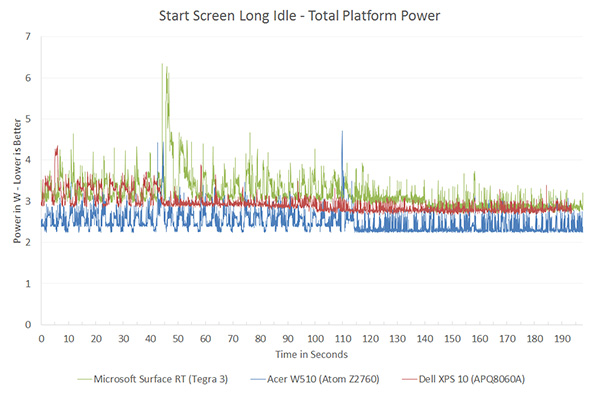
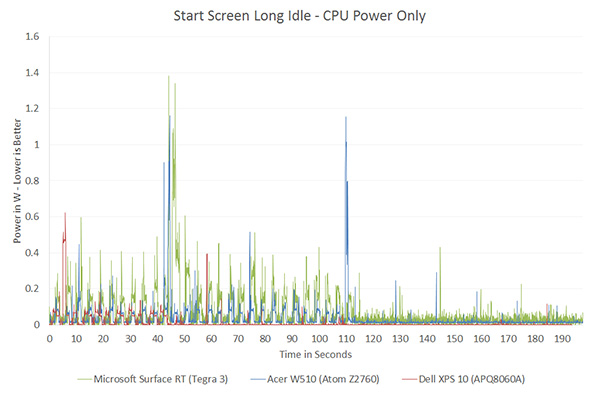
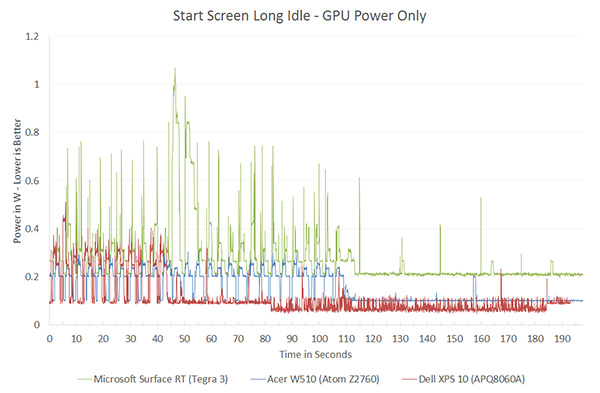
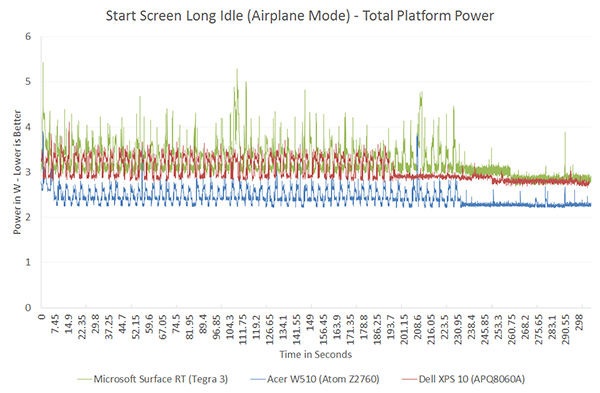
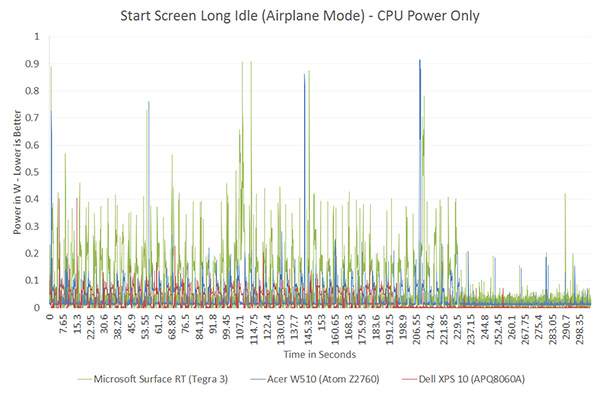
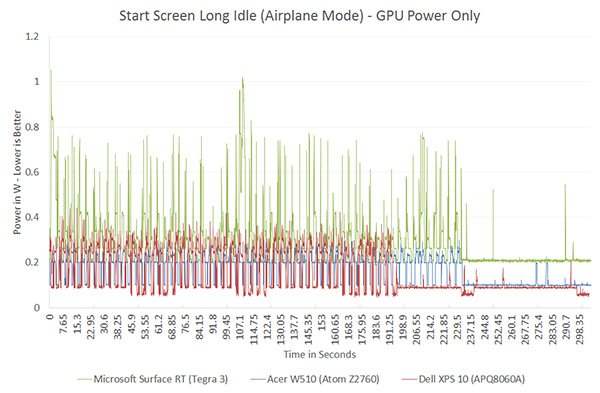








140 Comments
View All Comments
some_guy - Saturday, January 5, 2013 - link
I was reading comments about how Intel can't compete on price because it will cannibalize profits from higher margin chips.My sense is that Intel will aggressively attempt to squash ARM just like cored AMD. I think they are aware of the imminent threat.
Cannibalizing their own profits from higher margin chips is inevitable and may be a better choice than being eaten alive by ARM.
(BTW I didn't read all 11 pages of comments, so sorry if this was already stated.)
nofumble62 - Saturday, January 5, 2013 - link
Intel current margin is >60% but its stock price didn't rise an inch.The concern is about architecture and future.
As long as they can get into mobile and get market share back, their stock price will spike.
So YES, they can and will drop the price to compete. Their cheap smartphones are already in store in India, China, and Europe.
Don't forget that there are plenty of companies doing well with much smaller margin.
mugiebahar - Saturday, January 5, 2013 - link
While theory will agree, it's not so easy. Simple illustration (only in smart phone tablets)Company 1 (ARM) - employes 1 person and works from home.
Company 2 (Intel) - employes 100 people and rents a warehouse.
Cost to run business 1 - ?
Cost to run business 2 - ???
ARM owns the market now (just for now is all I'm saying) - revenue per expenses = great
Intel is negligible - revenue to expenses = disaster (not that won't change, but the
money spent already over the years)
Company 1 has loyalty and legacy in this market.
Company 2 is HOPING it has loyalty and the it legacy support will matter in this market!
The article makes it seem that it's a one deal Intel will be in the marke and we just have to wait. But that's wrong. Right now we are having phone that can do everything we need at the moment. Yes it will get better but we don't need the leaps n bounds anymore @ a cost we really don't need to spend.
Also if Intel sells a core CPU SoC and it goes for 20-30 like ARM SoC. uneducated people will look at it as an insult that the desk top costs so much. And while its completely different levels of power average joe won't know, and humans are the worst critics correct? I stated before its not about intel not being able to make a chip. It's their company s structured so wrong for this market. You have to be small and agie. AMD would have a better shot at it, if they had the smarts.
some_guy - Sunday, January 6, 2013 - link
It could get ugly.Intel will not give up the high end ARM market without a fight because next stop is desktop market. And Intel may not succeed.
Apple is already majorly moving away from Intel which gives the lots of leverage.
This may be Intel's long twilight, and AMD's shorter twilight.
CuriousSoul - Saturday, January 5, 2013 - link
Without knowing the Frames Per Second, Games settings for 3D Game 1 how is is possible to compare all of the graphs in any sense other than maximum mW ?It's like saying a VW Golf is more frugal around a race track than a Ferrari !
One resistor could draw 1mW and another 1000mW but which is better at the actual 3D Game 1? (in this case they offer an identical experience).
Cold Fussion - Saturday, January 5, 2013 - link
Yea this was mentioned multiple times before, It doesn't do very much to alleviate the claims of Anand's Intel bias does it?jameskatt - Sunday, January 6, 2013 - link
The first problem for Intel is that every major ARM chip company develops their own ARM chips. Apple does it. Samsung does it, etc. This means that these companies will NOT buy third party CPU/GPUs for their ARM devices. By developing their own ARM chips, they cut out Intel as the middle man and Intel's profits. For low priced devices, it is crucial to do this since margins can be very low or in Apple's case, the need to make profit is very high. These companies will not be Intel customers for chips. Intel is locked out. This is why Texas Instruments got out of the ARM business.The second problem for Intel is that the ARM-chips have a huge ecosystem supporting it. Apple has their iOS software kingdom with over a million apps. Android has it hundreds of thousands of apps. These ecosystems have a heavy momentum of their own. Their number dwarfs the number of apps available to the Intel platform. Thus Intel has a difficult job convincing anyone to incorporate its CPUs in to devices which will automatically be incompatible for the existing ecosystems.
What Intel can do is to simply keep aggressively developing its own chips so that they can compete strongly with the ARM chips so that Intel can keep the ecosystem it currently has - laptops, desktops, mainframe and supercomputers.
Intel won't be able to compete on price. it has to make its own profits. It won't be able to compete at the bottom of the device market. But it certainly can keep and expand its own arena. Microsoft surface tablets are an example of an attempt to keep its own ecosystem.
omind - Monday, January 7, 2013 - link
James,Intel is not trying to sell IP to existing ARM chip companies (Samsung, Nvidia etc) but instead are creating complete SOCs, including GPU, Video en- and decoders and so on. They are positioning themselves as competitiors to SOC manufacturers not as suppliers.
Secondly, the Atoms already in the market (Medfield) can leverage the Android app ecosystem. This is accomplished by a version of Android's Dalvik adapted to the x86 ISA. I personally own a Medfield-powered Motorola Razr-i and I can say that every single app I downloaded from Google's play store does run without any problem whatsoever on it. Contrary to the popular belief, there is no ecosystem problem for the end user.
Best regards
mrdude - Wednesday, January 9, 2013 - link
I think his point is that today the big device makers are also have their own SoCs, thus locking Intel out from the beginning. The push towards vertical integration threatens Intel drastically. And unlike a Qualcomm, Intel currently has very little to offer that stands out from the rest of the competition in the tablet and smartphone space (I say tablet because the sales of x86 tablets has been really poor. Consumers don't value x86 compatibility on their tablet)Intel just can't compete on price. I know this gets brought up endlessly but it's something that's absolutely true. Intel operates on sky high margins and that's something that's impossible to do if you're only making SoCs for tablets and smartphones. If the high end is cannibalized at an accelerating rate going forward (and the figures I've read point to this) then Intel is going to be in big big trouble. There's just no way the company can maintain its sky high margins and even keep its own fabs (and R&D) by selling ~$20 SoCs. It's just not gonna' happen. Either Intel provides something that only they can offer and that's wanted by every device maker and consumer and warrants a higher price tag or they begin their slow march downhill.
wsw1982 - Friday, January 11, 2013 - link
Intel sell much more processors today than they were in 2010/2009, if they can maintain their own fabs then, I don't see the reason why they cannot now. The $20-$30 SOC is new market for Intel, not a replacement (at least in near feature). The additional market should be welcomed, right? It reminded me that back to 2008 when Intel first introduced the ATOM, a lot of genius started to cry that Intel opened the netbook market and sale chip at $30 and it would cannibalize the notebook market and hurt Intel's profit. But the years after are one of intel's fast growing age.As for the price? Why cannot Intel compete? doesn't it have enough revenue (PC&Server revenue is much more than 2010 and 2009) to even up the R&D? does it need to pay a bloody foundry fee to TSMC (who alone enjoy 40% margin)? does it have to pay a license fee to ARM? Doesn't it already spend a forturn on PR? Doesn't it already have the manufacture volume ? (50% in idle, anyway will be wasted, why don't produce something at least earn some money)
And I think Intel is never as competitive as now. It gaining it position in server market for the last few year, it's pc business has never such high market share, it's mobile chip start to crush ARM in any respect.
http://www.phonearena.com/news/Intel-Atom-powered-...
check this out, the smart phone lenovo K900 score more than 25000 in Antutu on a 1080P display, which not only crush snapdragon pro (4 krait) in Optimus G but also the newly release Samsung Exynos 5440 (2 A15) in Nexus 10